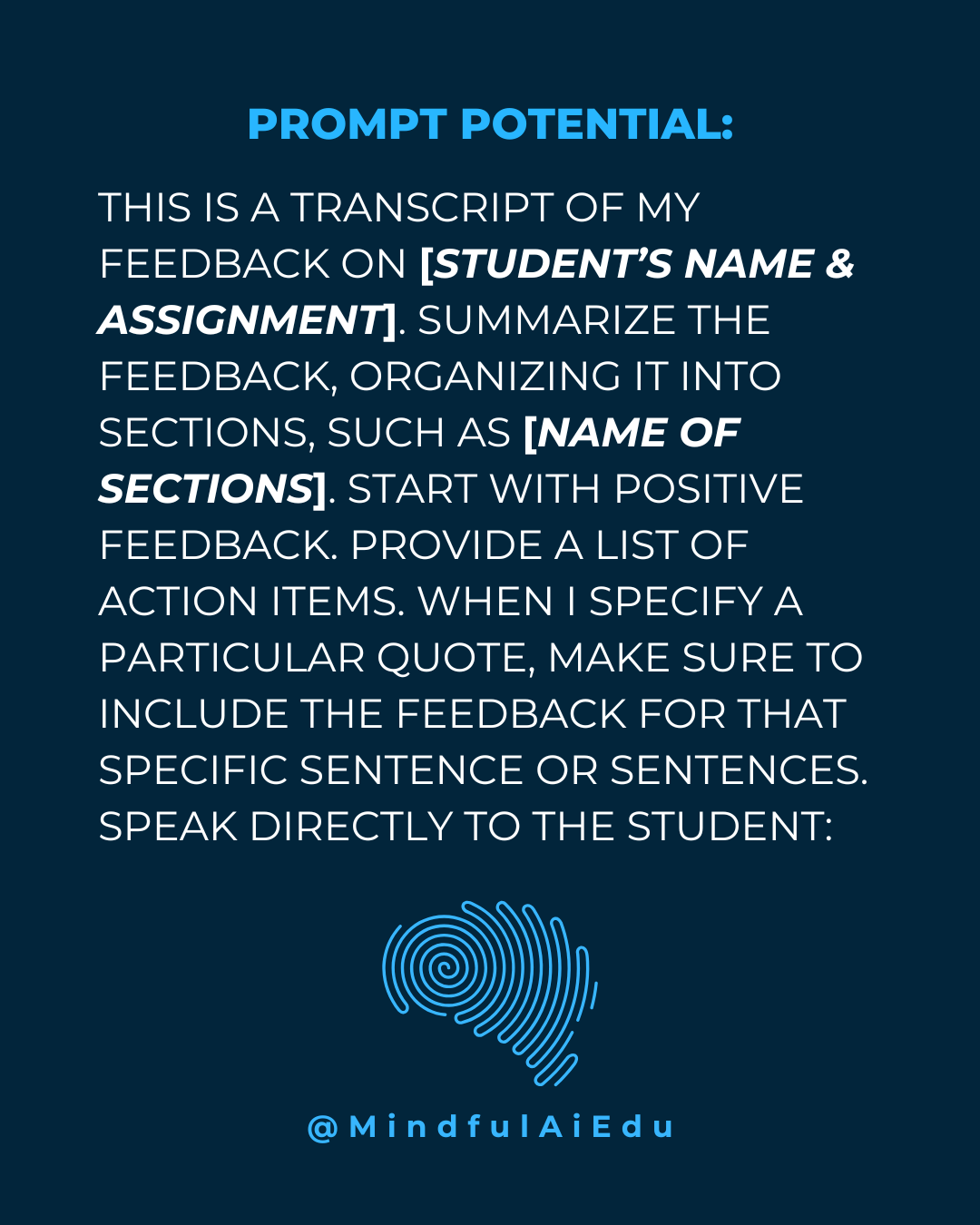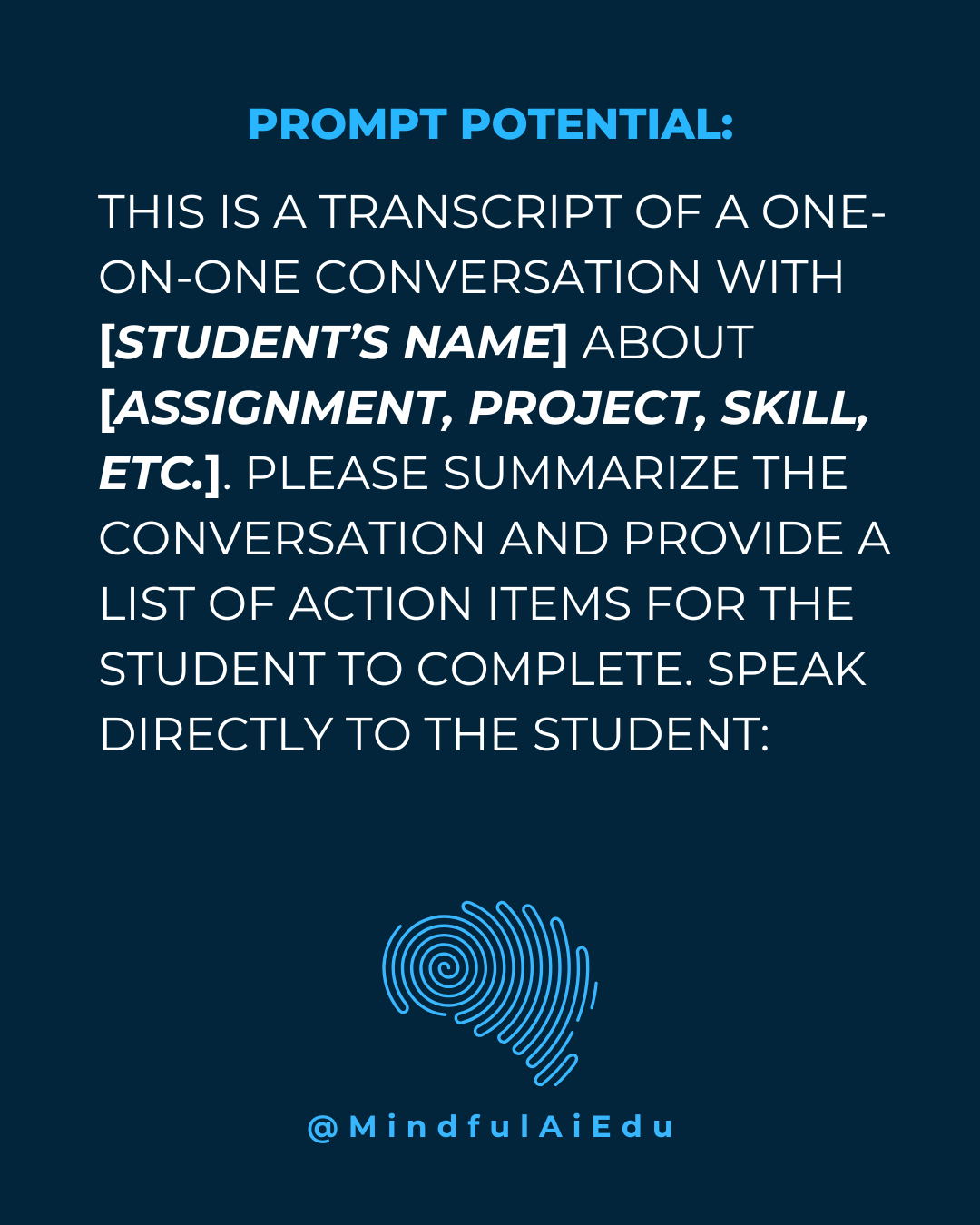Enhancing Feedback with AI: Making Feedback Clearer, More Meaningful, and More Human
AI process enables a shift from transactional student feedback to relational feedback
Offering meaningful feedback on student work shouldn’t be an obstacle to building connections with students. Correctly used, AI tools can provide innovative solutions to longstanding challenges, refocusing learning on student-teacher interactions.
ChatGPT prompt for image: A humorous cartoon illustration of a stressed-out teacher completely hidden behind an enormous, teetering stack of ungraded papers. Only their exhausted arms stick out from the sides—one holding a red pen and the other gripping a coffee cup. Lightning bolts of frustration spark above the paper stack, symbolizing the overwhelming
By Dr. Dani Kachorsky, Ph.D
One of the biggest game changers in my use of AI has been in streamlining and enhancing feedback for students. And honestly? I’m a little mad at myself for not figuring this out sooner. AI has completely transformed how I give students meaningful, individualized feedback—without adding to my already packed workload.
The Problem with Traditional Feedback Methods
Teachers have long experimented with different ways to deliver feedback, from written comments on assignments to one-on-one conferences. Some have used audio recordings or even video feedback, and I’ve seen these strategies pop up at professional development sessions for years. I always loved the idea of recording my feedback, but every time I tried to make it work, I ran into roadblocks.
For one, I talk in circles when I record feedback. I jump from idea to idea, something on page three reminds me of a comment I should have made about page one, and suddenly, my feedback sounds disjointed. And then there’s the self-consciousness factor—I wasn’t about to record video feedback unless I looked fully presentable, and let’s be real, that’s not happening every time I sit down to grade.
Then there was the issue of efficiency. I can type feedback faster than I can record, edit, and send an audio file, but typing is still time-intensive. When I experimented with conferencing as a feedback method, I loved the interaction, but in a noisy classroom, those conversations could be disorganized and easily interrupted. Students and I would both take notes, but inevitably, key points would get lost.
A Breakthrough at 30,000 Feet
I had my breakthrough in the most inconvenient of places—a cramped middle seat on a five-hour flight. I had 20 AP Research papers to get through, and my plan was to use the flight time to write feedback. But the second I opened my laptop, I realized there was no way I could type without elbowing the people next to me. I was, quite literally, stuck.
So I pivoted. I opened up the first student’s paper and started audio recording my feedback on my phone as I read, figuring that at least they’d get something useful from me. And by the time we landed, I had made it through almost all of the papers.
When I got home and reviewed the recordings, I immediately ran into all the issues I had anticipated—background noise from the plane, chimes from announcements, garbled words, and the realization that my feedback, while valuable, was messy. The transcripts were even worse. The AI transcription tool embedded in the phone app had turned my comments into an incomprehensible jumble in places—one student’s citation errors somehow consistently became “virgin errors” (which, yikes).
I knew I wasn’t about to spend hours cleaning up these transcripts manually. But then it hit me: what if AI could do the heavy lifting for me?
Turning Messy Audio into Streamlined, Actionable Feedback
I fed the transcripts into ChatGPT—our school's team license protects our data to make sure it is private and not used to train the model—and asked it to do three things:
Summarize my feedback
Organize it by section (e.g., Introduction, Literature Review, etc.)
Create a list of action items for the student
The first attempt wasn’t perfect—some student feedback got mixed up because I had recorded feedback for several students in a single audio file. However, once I separated each student’s feedback and fed each student’s transcript in separately, it worked beautifully.
AI filtered through the background noise and the messy transcripts to create a summary document that structured my feedback logically (even when my spoken feedback had been scattered) and pulled out actionable steps for students. Best of all, it kept my voice—this wasn’t AI writing feedback for me; it was just making my real-time feedback clearer and more useful.
Scaling the Process: Feedback for Writing and Conferences
After that initial success, I started using this AI-assisted feedback approach regularly, refining my process along the way. Now, when I record feedback, I make sure to say “quote” before reading a line from a student’s work and “end quote” after so the AI knows to extract it and connect my feedback specifically to that quote. I also prompt the AI to lead with positive feedback, making sure students first see what they did well before diving into areas for improvement.
I have since expanded this process beyond written feedback and into student conferences. My AP Research students meet with me regularly for one-on-one discussions about their projects, but these conversations can be chaotic. Students remember key points at random moments, conversations bounce between topics, and the notes we take don’t always capture everything.
Now, I record those meetings, run the transcripts through AI, and ask it to summarize our conversation, organize the feedback into sections, and generate a to-do list for the student. The AI even suggests follow-up questions for our next meeting, acting as a second brain to help me keep track of students’ progress.
Why This Works: AI as a Feedback Enhancer, Not a Replacement
The most important part of this process? The AI isn’t replacing my voice—it’s amplifying it. The feedback is still mine. The AI just removes the noise (literally and figuratively), organizes my thoughts, and makes everything more actionable for students.
This also frees me up to spend more time actually engaging with my students. Since I’m not bogged down with taking meticulous notes or trying to reconstruct our conversations later, I can focus on reading their work more deeply or having richer one-on-one discussions. Instead of scribbling notes during a student conference, I can be fully present, listening, asking better follow-up questions, and giving students my full attention.
And that shift—moving from transactional feedback to relational feedback—makes a huge difference. Students feel like I see them, not just their work. The classroom dynamic shifts from “performing for a grade” to “collaborating on learning.” I get to know them better, not just as students but as people, and they, in turn, feel more invested in their own progress.
This isn’t about handing over grading to a chatbot. It’s about reclaiming time while making feedback clearer, more meaningful, and more human. Instead of drowning in grading, I can focus on what actually helps students grow. And in a world where teachers are constantly being asked to do more with less, that is the real win.
Try It Now: AI-Powered Feedback Strategies for Your Classroom
Want to try this out in your own classroom? Here are some easy, actionable ways to start using AI to enhance feedback—without adding to your workload. Pick one to test out tomorrow! Start small, iterate, and make it your own.
1. Record & Summarize Your Feedback on Student Work
Instead of typing out feedback, record yourself speaking your thoughts as you read a student’s work. Then, use AI to transcribe and summarize your comments, making them clearer and more actionable for students. This works especially well for formative assignments or in-progress work where students need guidance rather than just a final evaluation.
2. Capture One-on-One or Small Group Conferences
If you hold conferences with students, try recording them (with their permission). Feed the transcript into an AI tool and have it generate a summary, organize key points, and list actionable next steps for the student. This allows both you and the student to focus on the conversation rather than worrying about taking notes.
3. Have Students Record Peer Review Sessions
Encourage students to record their peer review discussions and run them through AI to extract key feedback. This helps eliminate misunderstandings, ensures students actually engage in meaningful critique and allows them to revisit feedback later as they revise.
4. Have Students Record & Synthesize Small Group Discussions
If students are working in small groups—whether for literature circles, project discussions, or analysis activities—have them record their conversations and use AI to generate a summary of their discussion. They can submit both the original transcript and the AI summary to the teacher. This provides a quick way for teachers to track engagement, assess understanding, and identify key takeaways from student discussions without having to be present for every conversation.
If you try one of these strategies, let us know how it went! We would love to hear from you about your experiences using AI to enhance feedback. What worked? What didn’t? How did students respond?
Author’s Note:
This post was created using the same AI-assisted workflow I describe here. I began by audio recording my thoughts and experiences, then used AI to transcribe and synthesize my reflections while maintaining my voice. I added and revised material through a few additional prompts in the LLM interface before copying the content into a document, where I made further minor revisions to organization and clarity. This process allowed me to focus on refining my ideas while keeping the authenticity of my personal experiences at the center of the writing.





